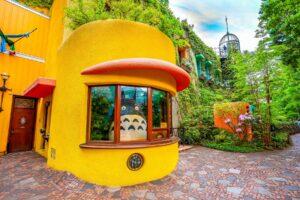Fodor's Expert Review Yasukuni Shrine
Founded in 1869, this shrine is dedicated to approximately 2½ million Japanese, Taiwanese, and Koreans who have died since then in war or military service. As the Japanese constitution expressly renounces both militarism and state sponsorship of religion, Yasukuni has been a center of stubborn political debate, particularly since 1978 when a shrine official added the names of several class-A war criminals to the list. Numerous prime ministers have visited the shrine since 1979, causing a political chill between Japan and its close neighbors, Korea and China, who suffered under Japanese colonialism. Despite all this, hundreds of thousands of Japanese come here every year, simply to pray for the repose of friends and relatives they have lost. These pilgrimages are most frenzied on August 15, the anniversary of the conclusion of World War II, when former soldiers and ultra-right-wing groups descend upon the shrine's grounds en masse.
The shrine is not one structure but a complex... READ MORE
Founded in 1869, this shrine is dedicated to approximately 2½ million Japanese, Taiwanese, and Koreans who have died since then in war or military service. As the Japanese constitution expressly renounces both militarism and state sponsorship of religion, Yasukuni has been a center of stubborn political debate, particularly since 1978 when a shrine official added the names of several class-A war criminals to the list. Numerous prime ministers have visited the shrine since 1979, causing a political chill between Japan and its close neighbors, Korea and China, who suffered under Japanese colonialism. Despite all this, hundreds of thousands of Japanese come here every year, simply to pray for the repose of friends and relatives they have lost. These pilgrimages are most frenzied on August 15, the anniversary of the conclusion of World War II, when former soldiers and ultra-right-wing groups descend upon the shrine's grounds en masse.
The shrine is not one structure but a complex of buildings that include the Main Hall and the Hall of Worship—both built in the simple, unadorned style of the ancient Shinto shrines at Ise—and the Yushukan, a museum of documents and war memorabilia. Also here are a Noh theater and, in the far western corner, a sumo-wrestling ring. Sumo matches are held at Yasukuni in April, during the first of its three annual festivals. You can pick up a pamphlet and simplified map of the shrine, both in English, just inside the grounds.
Refurbished in 2002, the Yushukan presents Japan at its most ambivalent—if not unrepentant—about its more recent militaristic past. Critics charge that the newer exhibits glorify the nation's role in the Pacific War as a noble struggle for independence; certainly there's an agenda here that's hard to reconcile with Japan's firm postwar rejection of militarism as an instrument of national policy. Many Japanese visitors are moved by such displays as the last letters and photographs of young kamikaze pilots, while others find the Yushukan a cautionary, rather than uplifting, experience.
Although some of the exhibits have English labels and notes, the English is not very helpful; most objects, however, speak clearly enough for themselves. Rooms on the second floor house an especially fine collection of medieval swords and armor. Visiting on a Sunday offers a chance to forage at the flea market that runs from morning until sundown.
READ LESS








